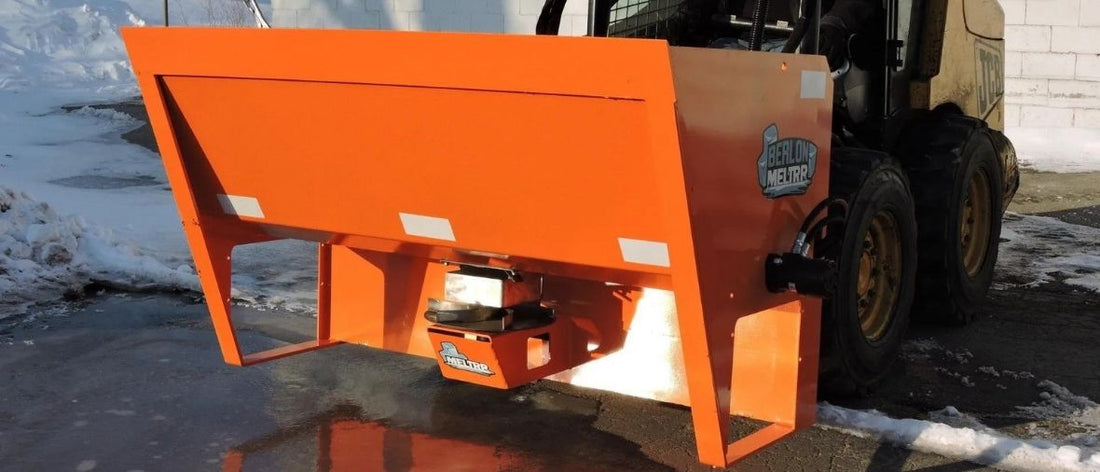
Sand Or Salt For Winter Maintenance?
Share
If you are thinking about using your new skid steer salt spreader attachment to manage ice and snow this winter, you might be wondering if using salt or sand is going to be the most effective? I’m going to help answer this question. We will take a look at both materials, including their benefits and draw backs.
What Is Road Salt?
Road salt, also known as “rock salt” is the same salt you use at the dinner table, with the exception that the salt crystals are much larger, hence the name “rock salt”.
Rock salt is mined from underground salt mines. The salt exists underground an account of ancient salt water seas that dried up thousands of years ago. Today miners build underground shafts to reach these salt deposits, and use controlled explosions to break off manageable amounts.
After the salt has been extracted from the earth, it is crushed and screened into various sizes. Some manufacturing processes involve dissolving the salt back into a brine so that it can be further purified. The salt is then extracted again from the brine using heat and natural evaporation.
How Does Salt Melt Ice?
Most of us are already aware that water freezes at 32° F. But interestingly enough, when you add salt to water, this is no longer the case.
Salt acts as a “freezing point depressant”, which means that the salt makes it more difficult for water molecules to bond together to form a rigid structure.
But how does this work if there is already a layer of ice on the ground?
When you have a layer of ice on the ground,, there will be a small layer of water on top of the ice.
This layer of water will be in a constant tug of war with the ice beneath it. The ice trying to freeze the layer of water, and the layer of water trying to thaw the ice.
Adding salt to the layer of water on top of the ice prevents the ice below from being able to freeze it.
Now that the water on top of the ice has the advantage in the tug of war, it will slowly melt the ice beneath it.
This only works when temperatures are near freezing. In extreme cold temperatures, there will not be a layer of water on top of the ice. The layer of water is essential to the salt being able to melt the ice. Without the water, the salt has no way of dissolving.

How Does Road Sand Work?
There are some situations where salt is a poor option. Like mentioned above, in extreme cold, salt will not be effective. And as we will talk about later, salt can be a poor option in certain sensitive environments.
This is where sand can fit in. Sand is often used on road ways to add traction for motorists, where the ice can not be effectively melted. This is a common practise in northern parts of Canada.
In order for sand to provide traction, it needs to be gritty. Therefore, the sand used in ice management is often much coarser than the sand in your backyard sand box. The sand being applied to the road is often wetted down with a mixture of water and freezing point depressant to make it heavier so it does not blow away once it is applied to the road.
Common Concerns About Salt and Sand
Whether you have decided on salt or sand, before you start filling up your skid steer material spreader, it’s important to consider the environment you are applying the material too, and it’s potential harms.
The salt applied to road ways, parking lots and sidewalks isn’t going to stay stationary. As the salt mixes with water and turns into a brine, it’s going to easily travel through the sewer system, into lakes, marshes, ponds, ditches, yards and gardens.
In large concentrations, salt is deadly to many fresh water species. Studies have suggested that road salt being applied near water ways for decades has changed the entire ecosystem of lakes and marshes.
We also must consider that plants and gardens are unable to survive in an environment with a high salt concentration. When a plant has a higher salt concentration on the outside of its cells than on the inside, the salt draws the water out of the plants cells which will eventually kill the plant.
Salt on the other hand is often deemed to be the more environmentally responsible option. It is however not without its draw backs as well.
Road sand often ends up in our lakes and water ways in the same way road salt does. The increase in sediment can change the natural flow of our water systems as well as increase turbidity.
Bacteria, parasites and viruses can attach them selves to the sand particles in our water ways, negatively effecting the health of many ecosystems. Increased turbidity can also effect aquatic species that rely on good visibility for catching prey and laying eggs.
Statistics
- Each year over 48 billions tons of road salt are used in America
- Road salt reduces accidents by up to 88% (Marquette University)
- Snowstorms cost over $700 million per day if roads are impassable
- Winter road maintenance accounts for 20% of DOT budget (Federal Highway Administration)
- For every 10% increase in road traction a 20% decrease in accidents follow (American Highway User Alliance).
Salt Or Sand?
This brings us back tour original question, should I spread salt or sand with my skid steer spreader attachment?
As you can see from the statistics, winter road Maintenace is an important and necessary job. Your choice between salt and sand should keep the safety and well being of the public in mind, while remaining environmentally responsible and economical.
The Case For Salt
Consider the expected temperature when deciding if salt is a good option for winter maintenance.
Overall, salt works best at temperatures closer to freezing, because it needs a thin layer of water on top of the ice in order to dissolve. Salt should not be considered as an option in extreme cold environments for the same reason.
A draw back to salt is that it takes some time to melt the ice, where as sand will start providing traction immediately.
Salt use should be carefully considered and applied at the minimum rates required when using it near water ways and other sensitive natural areas.
The Case for Sand
In climates that become extremely cold in the winter months, sand is your best option. Given situations where melting ice is impractical, the best option is to provide traction on the ice.
Another benefit to sand is that it starts providing traction benefits immediately. There is no waiting period as there is with salt.
Sand may however need to be applied more often than salt, and this can be a major drawback. Fresh snow fall, high winds, and just regular vehicle and foot traffic may relocate the sand and remove traction from the surface.

